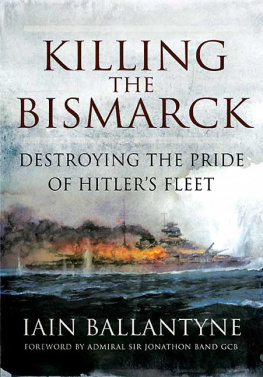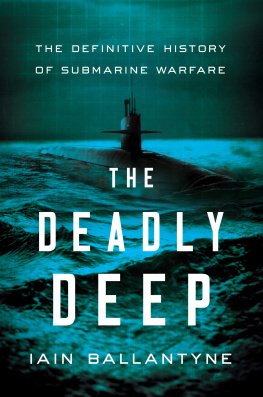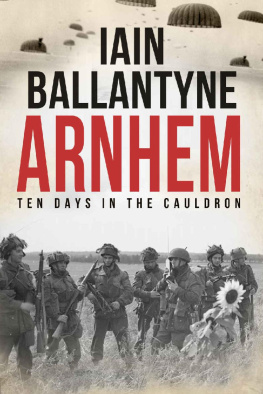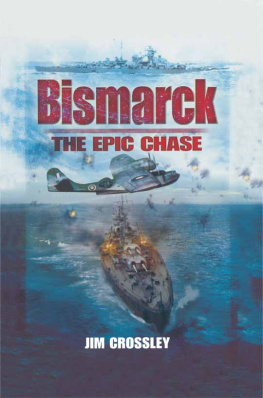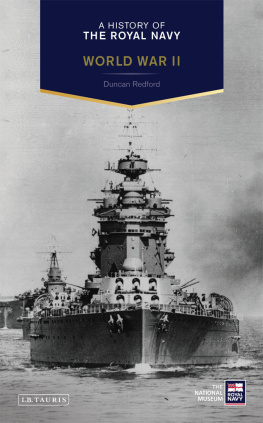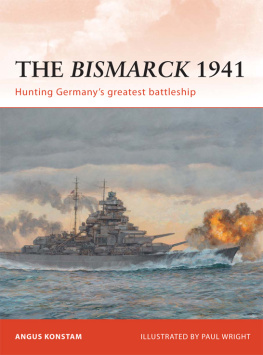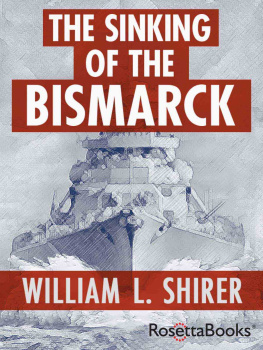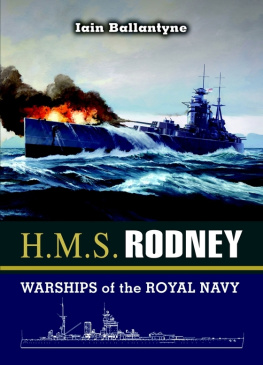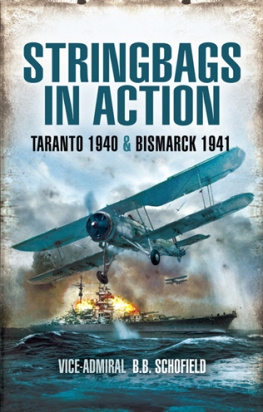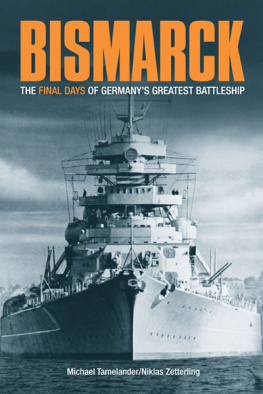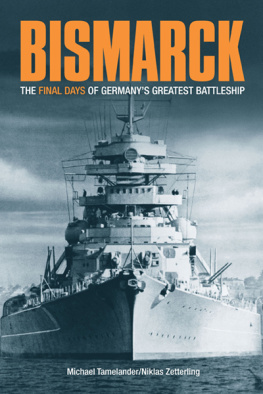Other books by Iain Ballantyne
Strike from the Sea: The Royal Navy & US Navy at War in the Middle East 19492003
Warships of the Royal Navy series
Warspite
HMS London
HMS Victory (With Jonathan Eastland)
HMS Rodney
All titles published by Pen & Sword Books

First Published in Great Britain in 2010 by
Pen & Sword Maritime
an imprint of
Pen & Sword Books Ltd
47 Church Street
Barnsley
South Yorkshire
S70 2AS
Copyright Iain Ballantyne 2010
ISBN 978-1-84415-983-3
ePub ISBN: 9781848849600
PRC ISBN: 9781848849617
The right of Iain Ballantyne to be identified as Author of this Work has
been asserted by him in accordance with the Copyright, Designs and
Patents Act 1988.
A CIP catalogue record for this book is available from the British Library.
All rights reserved. No part of this book may be reproduced or
transmitted in any form or by any means, electronic or mechanical
including photocopying,recording or by any information storage and
retrieval system, without permission from the Publisher in writing.
Typeset in 11pt Ehrhardt by
Mac Style, Beverley, E. Yorkshire
Printed and bound in the UK by CPI
Pen & Sword Books Ltd incorporates the imprints of Pen & Sword
Aviation, Pen & Sword Maritime, Pen & Sword Military, Wharncliffe
Local History, Pen and Sword Select, Pen and Sword Military Classics and
Leo Cooper
For a complete list of Pen & Sword titles please contact
PEN & SWORD BOOKS LIMITED
47 Church Street, Barnsley, South Yorkshire, S70 2AS, England
E-mail:
Website: www.pen-and-sword.co.uk
Contents
Appendices
For Robert and James
May they never have to fight such battles.
In the words of the great Paddy McAloon,
lets hope those kinds of conflicts are
as obsolete as warships in the Baltic.
From the first verse of Faron Young , from Prefab Sprouts Steve McQueen album (1985).
Foreword
T he sinking of the Bismarck was one of the defining moments of war at sea in the European Theatre and has generated considerable historical study and comment. One might therefore question the value of another book on the subject. My judgement is that this book adds new material and provides us with additional and different reflections on issues that this action has previously raised.
I am particularly struck by the well-researched accounts from a good cross-section of personnel. They, together with the narrative, bring out so much that is enduring about navies and their operations as well as the specifics of this particular operation. The enduring importance of range, damage control and logistics come through strongly in this book, which also shows us the decisive use of naval air power for both reconnaissance and attack.
No commander plans or executes an operation without an eye on the weather. It can be both an enemy and a friend at the same time and this was the case in May 1941. The same weather that made carrier flying so challenging also frustrated the U-boats.
The sheer professionalism of the ships companies so evident in this action, as is related on the following pages, was the bedrock of the successes that the Royal Navy ground out in the Atlantic, in the Mediterranean and finally in the Pacific over the next four years. It is, of course, part of the legacy that todays sailors and marines aspire to match.
The eyewitness accounts quoted in this book confirm vividly the ferocious pounding the Home Fleet gave the Bismarck to ensure her sinking. Additionally, they give support to the view that there was something very personal as well as operational and strategic about the need to destroy Bismarck . The loss of the Hood , although technically not surprising she was never given the required modernization -was a huge shock to the Nation as well as the Royal Navy.
Between wars it is always a challenge to continue to afford modernization. This was certainly the case for the Royal Navy and Hood was a prime example of that. In the 1940s the Royal Navy had to rely on too many ships of First World War vintage, including battlecruisers, which were known to be susceptible to plunging shellfire due to inadequate levels of protection.
In considering the strategic context of the story that unfolds here, we must remember that Britain stood very much alone in May 1941. Major reverses had been suffered on the ground. While the threat of invasion had been removed by the successes of the RAF in the Battle of Britain, the German bombing campaign against the cities was in full swing.
The Royal Navy was stretched across the Atlantic and Mediterranean and paying the price for insufficient investment in the 1920s and the late decision to rearm in the 1930s. Add to this the consequences of Arms Control agreements and the Admiralty and Fleet Commanders were at times looking down the barrel of defeat. To have lost the Hood and let Bismarck avoid retribution would have had a devastating effect on morale and reputation, the latter being particularly important in the perception of the United States and Soviet Union.
The operational, potentially strategic, leverage the German Navy would have been able to exert with the Bismarck joining Scharnhorst and Gneisenau in the Atlantic ports, while undertaking the U-boat campaign, might well have put the Royal Navy past the tipping point. This well written and absorbing book reminds us how this situation was avoided while clearly illustrating the home truths about war at sea. I commend it to you.
Admiral Sir Jonathon Band GCB Former First Sea Lord & Chief of Naval Staff
Acknowledgements
T he genesis of this book can be traced back almost two decades to a conversation over a pint of beer in a Plymouth pub. I was the Defence Reporter of the citys evening newspaper and had arranged to meet a group of men who had served in the battleship Prince of Wales during the Second World War, in order to take notes on their experiences for an article that was part of a series on milestones in that conflict. Working in a naval city, which had recently seen its sailors and marines involved in the effort to eject Iraqi troops from Kuwait, it was fascinating to talk to an older generation who had participated in the titanic struggle against fascism of the 1940s. I had been out to the Gulf, spending time in naval vessels engaged in operations applying pressure on Saddam and also aboard warships off the stricken emirate as its oil wells burned. Having gained some insight into life at sea aboard warships it was the first time British naval forces had been on a proper war footing since the Falklands campaign of 1982 I had become acquainted with the character of the Royal Navy and its people. In 1990/1, cheerful sailors and marines carried out a job that required great patience and fortitude in trying conditions, for which they got little thanks from a nation that seemed ignorant of the naval dimension of war. By the early 1990s the citizens of the British Isles appeared unable to comprehend the very things that made Britain a great (secure and prosperous) nation: its navy and the control of the sea. As the veterans of Prince of Wales , joined by a few from Repulse , another Plymouth ship, chatted with me about their experiences I recognised that the essential spirit of the Royal Navy half a century earlier was much the same in the 1990s. Of course, their experiences were so much more dramatic than those of younger generations of sailors and marines, for the Second World War was a globe-spanning drama the like of which we will, hopefully, never see again.
The remarkable men of the greatest generation, as they have been called, endured so much. Prince of Wales , as her veterans told me, was straight into action out of the builders yard, took part in the pursuit of the Bismarck , then carried Winston Churchill to the USA. She then battled through a hard-fought Malta convoy run and was sent to the Far East. One supreme irony revealed to me, as we supped our pints in that pub, was that Prince of Wales was so busy her sailors and marines never got to sail into their home port of Plymouth. Back then they had never enjoyed a run ashore down Union Street in each others company, to visit pubs, sup ale and spin dits [tell stories]. What finally brought them together in Plymouth those that survived the war and the ravages of time were annual gatherings, during which they would place a wreath at the magnificent Naval War Memorial on the Hoe and say a prayer for lost shipmates. On that same memorial you will find the names of men from other ships lost in the war that also took part in the epic pursuit and destruction of Bismarck .
Next page
